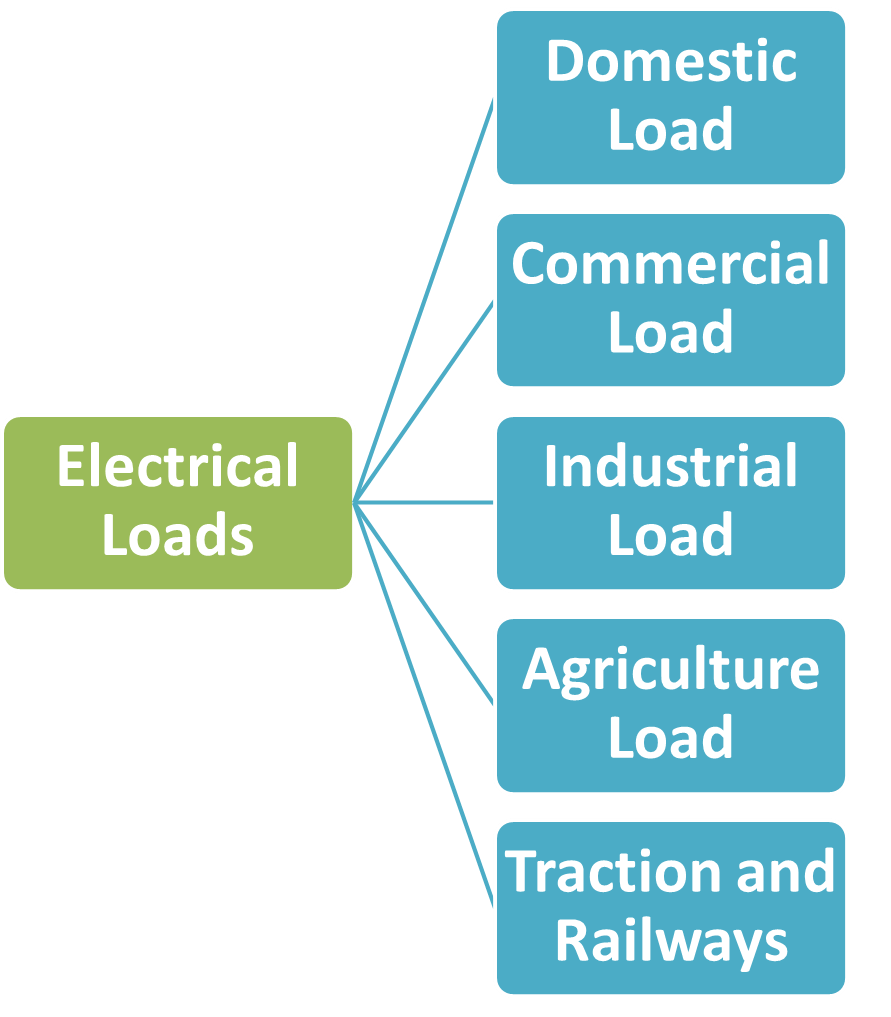The electrical load may be defined as the consumption of active and reactive power by an electrical appliance to utilize it for giving the required output from the appliance. It may also be the active and reactive power consumed by all the electrical appliances connected to particular premises such that the electrical appliances produce the desired output. They may be single-phase or three-phase, domestic and commercial types.
Types of Electrical Loads

The categorization of loads are done in order to have different tariffs (band of power that a consumer can use and pay amount corresponding to that slab) can be collected from the consumers. By having different slab rates for the power consumer, the consumers who consume the least (e.g., household) are made to pay judiciously as compared to the consumer who consumes heavy power (e.g., industry). The loads may be resistive, capacitive and inductive in nature. The various types of loads are:
Domestic Load
They are single phase loads connected to a three-phase transformer. They are household loads. The household loads may have fans, air conditioners, refrigerators, lights, television, etc. They have their demand for 24 hours and may vary from time to time in a day and in a year. The load factor is low at 10% to 20%.
Commercial Load
Commercial loads are the ones like the shops and malls. Their main power consumption is for lighting and airconditioning. They need the power during a particular time duration in a day. There may be special occasions like festival times and discount sales times where they may work for more time. The types of commercial loads are canteens/pubs, cloths and shoes, surgeries, grocery and bakery, etc.
Industrial Loads
They may be small scale, large scale and medium scale industries. The industries may be petrochemical, pesticides, pharmaceuticals, pulp and paper, tannery, etc.
Agriculture Loads
They are generally pumps which runs during nights. They are the pumps installed to supply to water for the irrigation and agriculture.
Traction and Railways
These types of loads include rope cars, trolley busses, tram cars, railways, etc. They may be public transport and hence will be maximum during the morning and evening hours.
Importance of Electrical Load
Loads are important part of the power system. They are the need or demand as it is technically called as. The power producers promise the consumers who use the loads with certain standards of power supply, like voltage within certain band and frequency also within certain band. If this is violated in today’s scenario the power producing company may be taken action legally. Hence proper supply system should be ensured to the consumers. This can be done by an in-depth understanding of the loads and its various types, its characteristics, etc. Most of our household appliances are single phase, Examples are television, microwave oven, air conditioner, hair drier, iron box are single phase. They are operated at different times of the day. Their usage may differ for a month and an entire year. During a month there may be increasing or decreasing number of family members. During an year there may be different seasons like summers and winters. On the whole it is the duty of the substations nearer to the household consumers or small consumers for single phase power, to deliver the right amount of balanced power. In case of shortage of power like loss of a generator or imbalance in the power system these consumers can be given first preference for load shedding.
The industrial consumers are the important lot a consumers, whose productions cannot be stopped. If done so, may cause crores of economical loss for the industry and to the nation. They are essentially three-phase consumers, be it small scale industries or large scale industries. The substations connected to them should ensure “peak hour” supply of power to these industries. They are not an option for load shedding unless there is a major fault and grid separation.
Effects of Variable Electrical Loads on Power System
When a particular part of the power (city, colony, industries, etc.) systems is planned, the load of that part is calculated on certain assumptions. Based on the total load, the active and reactive power requirements, the generation, transmission and distribution is planned. Once the planning is done, the installation is done based on the demand taking some projected upper limit. After the city is planned and after some years the demand of the same area goes above the projected limit. These may be due to the sophistication or development of that particular area. In order to cater to these demands, the following measures have to be taken.
Increasing Generation
The existing generating capacity may be increased by installing a generator in an existing plant or planning and installing a new power plant. The increasing demand may also be satiated by spinning reserve. This increases the cost of production and the tariffs has to be revised.
Installing Higher Capacity Devices
If the generation and the demand increases the protective devices and the associated measuring devices, relays and others should be upgraded accordingly. This also increases the cost and has to be taken care in tariffs.
Power Factor Improvement
When the load is increased there are chances that the power factor of the system reduces. This means that there is more reactive power consumption. But the generator is deviced to deliver a certain amount of reactive power. Therefore special devices are installed at various points that are economical and improves the power.
Transformers, Cables and Others
As the capacity is increased the transformers, cables and protective devices should be upgraded. The appropriate capacity of transformers, cables and transmission lines should be installed. The effects of increasing the loads on the power system, incidentally increases the cost of production and transmission of power. This in turn puts burden on the consumer. If the capacity has to be increased, new transmission lines has to be errected. This posses getting right of way for the excess capacity.